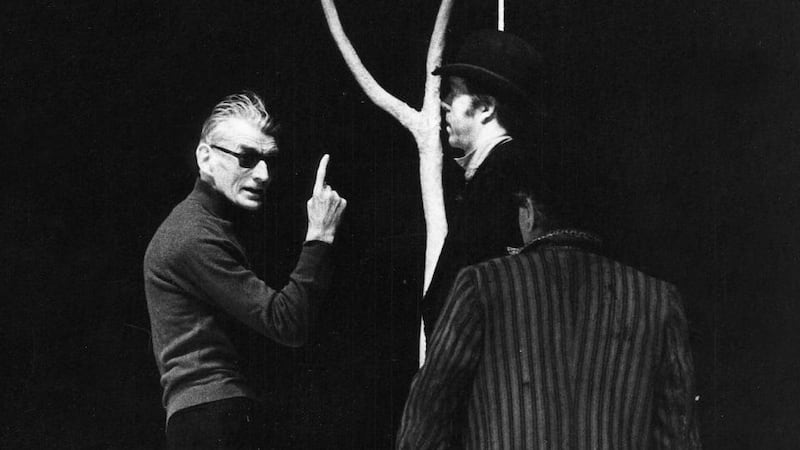Quite the out-of-body experience striding down the Avenue Rene Coty and watching the blue dot that represents your slow progress on Google maps walk straight through the red dot that represents Allée Samuel Beckett. Like a mutant from the Xavier school in the X-Men, you ghost through the solid object and come out the other side intact.
Far too much existential exposure for this time of the morning on the early amble around the 14th district to find yourself passing through something as concrete and substantial as the Allée Samuel Beckett without even knowing.
Here to walk and breathe in the space where he lived in Paris and see how he was honoured by the French for his work with the resistance during the second World War, there’s a more prosaic aspect to the Nobel Prize-winning author in that he was a rugby man.
Beckett lived long enough to be aware that in 1987 New Zealand beat his adopted country France in the first Rugby World Cup final in Auckland.
RM Block
But this is all so confusing – and Beckett being an absurdist, absurd too. Here you are one moment, excitedly racing past the short queue into Les Catacombes de Paris at place Denfert-Rochereau, persisting with the treasure hunt only to find that Allée Samuel Beckett appears to be a ghostly artefact, placed on maps of Paris but not actually there.
You pass the same spot six or seven times, go around the back of the unremarkable building that occupies the pinned dot on the map, which you have repeatedly walked through and emerged out the other side, but there is no sign or marking, cutting, aperture, division, gully or cove that looks like an Allée Samuel Beckett. The question is, has it ever existed?
There’s a pathway with seats on either side that cleaves Avenue Rene Coty and runs up what would be the centre line of the road, but as for signage, markings, symbols or assurances that this was Beckett’s turf, there are none.
Critics say his famous work Waiting for Godot is a play where nothing happens twice. Here we are at Allée Samuel Beckett, modern technology insisting this is the exact spot, with nothing happening even once.
There is a popular, but unproven theory, one too good not to retell and keep alive, of how Beckett came up with the name of his famous play. Somewhere in Paris the writer asked a crowd on the street what they were doing. The answer that came back was they were “waiting on Godot”, a notoriously old and slow rider in the Tour de France, who had still not yet passed, long after the peloton had flashed by and disappeared. It’s an appealing story as the Foxrock man not only followed Ireland’s fortunes in rugby, but also had interests in cycling and golf.

In Dublin he was a member of two golf clubs close to where he lived, Foxrock and Carrickmines. In the centenary history of the Carrickmines club, compiled by Marcus Webb and John Briggs and titled On Carrickmines Hill, member Billy Cunningham recalled how Beckett, who played in The Barton Cup, carried few clubs and putted with a two iron.
If he were alive today there’s little doubt he would have closely followed what is taking place all over France with a particular interest in the team based in Tours and which is about to face Scotland in their next match.
Beckett’s rugby interest came from his school days in Enniskillen, cricket and rugby being the prominent winter and summer sports for the boys in Royal Portora.
His chosen biographer James Knowlson, who wrote the insightful Damned To Fame, claimed that far from Beckett being morose and melancholic, he had a good sense of humour and wit.
Knowlson noted that Beckett wouldn’t take appointments on Saturday afternoons during what would have been for him the Home Nations Championship and latterly the Five Nations Championship season. His death in 1989 means he never got to experience the current Six Nations Championship format which was introduced in 2000 when Italy joined the competition.
Beckett was also recently revived in another contact sport, one of his lines now an overused but favourite for athletes and coaches across the globe. Borrowing from his prose work Worstword Ho in 2016, John Kavanagh put it in a Tweet after Conor McGregor lost in the UFC for the first time in his career to Nate Diaz.
“Ever tried. Ever failed. No matter. Try Again. Fail again. Fail better. Congrats to Nate and his team on a great win,” said Kavanagh introducing literature to the cage world.
Beckett played rugby on the school team and at Trinity College Dublin, once declaring that former Ireland outhalf Ollie Campbell was a genius. He was good enough at cricket to have his obituary printed in Wisden.
It began: “BECKETT, SAMUEL BARCLAY, who died in Paris on December 22, 1989 aged 83, had two first-class games for Dublin University against Northamptonshire in 1925 and 1926, scoring 35 runs in his four innings and conceding 64 runs without taking a wicket. A left-hand opening batsman, possessing what he himself called a gritty defence, and a useful left-arm medium-pace bowler . . .”
For a celebrity artist, who avoided glare and fuss, Allée, more than Avenue or Boulevard Samuel Becket seems wholly appropriate. And if you can find the Allée, even better.





















